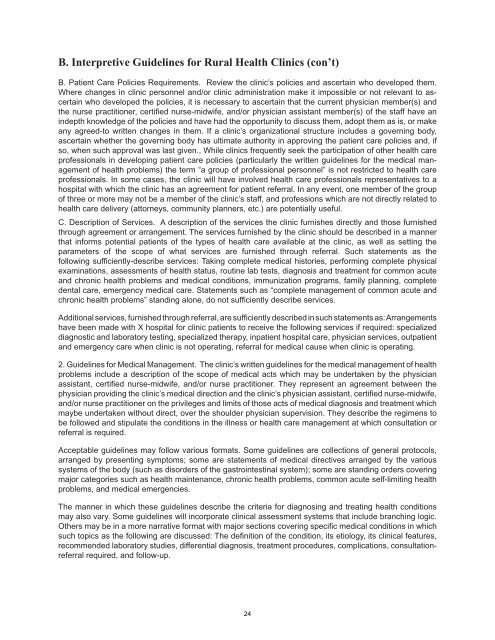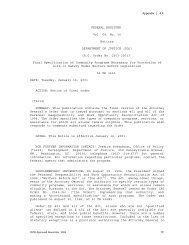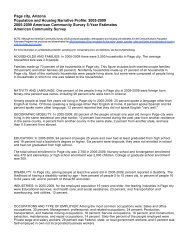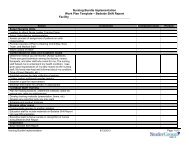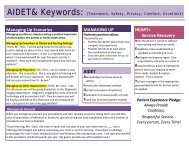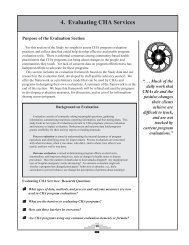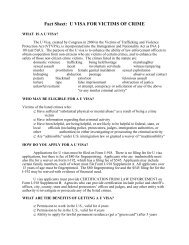Arizona Rural Health Clinic Designation Manual - Arizona Center for ...
Arizona Rural Health Clinic Designation Manual - Arizona Center for ...
Arizona Rural Health Clinic Designation Manual - Arizona Center for ...
You also want an ePaper? Increase the reach of your titles
YUMPU automatically turns print PDFs into web optimized ePapers that Google loves.
B. Interpretive Guidelines <strong>for</strong> <strong>Rural</strong> <strong>Health</strong> <strong>Clinic</strong>s (con’t)<br />
B. Patient Care Policies Requirements. Review the clinic’s policies and ascertain who developed them.<br />
Where changes in clinic personnel and/or clinic administration make it impossible or not relevant to ascertain<br />
who developed the policies, it is necessary to ascertain that the current physician member(s) and<br />
the nurse practitioner, certifi ed nurse-midwife, and/or physician assistant member(s) of the staff have an<br />
indepth knowledge of the policies and have had the opportunity to discuss them, adopt them as is, or make<br />
any agreed-to written changes in them. If a clinic’s organizational structure includes a governing body,<br />
ascertain whether the governing body has ultimate authority in approving the patient care policies and, if<br />
so, when such approval was last given., While clinics frequently seek the participation of other health care<br />
professionals in developing patient care policies (particularly the written guidelines <strong>for</strong> the medical management<br />
of health problems) the term “a group of professional personnel” is not restricted to health care<br />
professionals. In some cases, the clinic will have involved health care professionals representatives to a<br />
hospital with which the clinic has an agreement <strong>for</strong> patient referral. In any event, one member of the group<br />
of three or more may not be a member of the clinic’s staff, and professions which are not directly related to<br />
health care delivery (attorneys, community planners, etc.) are potentially useful.<br />
C. Description of Services. A description of the services the clinic furnishes directly and those furnished<br />
through agreement or arrangement. The services furnished by the clinic should be described in a manner<br />
that in<strong>for</strong>ms potential patients of the types of health care available at the clinic, as well as setting the<br />
parameters of the scope of what services are furnished through referral. Such statements as the<br />
following suffi ciently-describe services: Taking complete medical histories, per<strong>for</strong>ming complete physical<br />
examinations, assessments of health status, routine lab tests, diagnosis and treatment <strong>for</strong> common acute<br />
and chronic health problems and medical conditions, immunization programs, family planning, complete<br />
dental care, emergency medical care. Statements such as “complete management of common acute and<br />
chronic health problems” standing alone, do not suffi ciently describe services.<br />
Additional services, furnished through referral, are suffi ciently described in such statements as: Arrangements<br />
have been made with X hospital <strong>for</strong> clinic patients to receive the following services if required: specialized<br />
diagnostic and laboratory testing, specialized therapy, inpatient hospital care, physician services, outpatient<br />
and emergency care when clinic is not operating, referral <strong>for</strong> medical cause when clinic is operating.<br />
2. Guidelines <strong>for</strong> Medical Management. The clinic’s written guidelines <strong>for</strong> the medical management of health<br />
problems include a description of the scope of medical acts which may be undertaken by the physician<br />
assistant, certifi ed nurse-midwife, and/or nurse practitioner. They represent an agreement between the<br />
physician providing the clinic’s medical direction and the clinic’s physician assistant, certifi ed nurse-midwife,<br />
and/or nurse practitioner on the privileges and limits of those acts of medical diagnosis and treatment which<br />
maybe undertaken without direct, over the shoulder physician supervision. They describe the regimens to<br />
be followed and stipulate the conditions in the illness or health care management at which consultation or<br />
referral is required.<br />
Acceptable guidelines may follow various <strong>for</strong>mats. Some guidelines are collections of general protocols,<br />
arranged by presenting symptoms; some are statements of medical directives arranged by the various<br />
systems of the body (such as disorders of the gastrointestinal system); some are standing orders covering<br />
major categories such as health maintenance, chronic health problems, common acute self-limiting health<br />
problems, and medical emergencies.<br />
The manner in which these guidelines describe the criteria <strong>for</strong> diagnosing and treating health conditions<br />
may also vary. Some guidelines will incorporate clinical assessment systems that include branching logic.<br />
Others may be in a more narrative <strong>for</strong>mat with major sections covering specifi c medical conditions in which<br />
such topics as the following are discussed: The defi nition of the condition, its etiology, its clinical features,<br />
recommended laboratory studies, differential diagnosis, treatment procedures, complications, consultationreferral<br />
required, and follow-up.<br />
24


